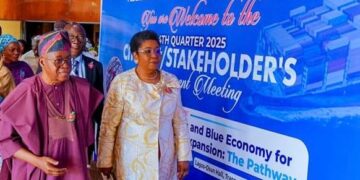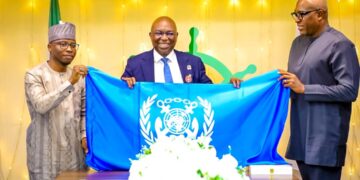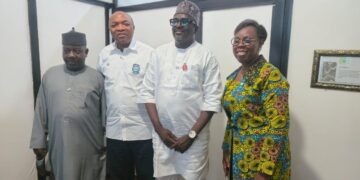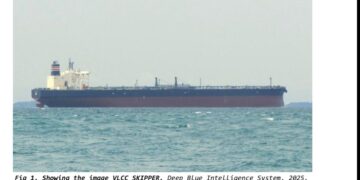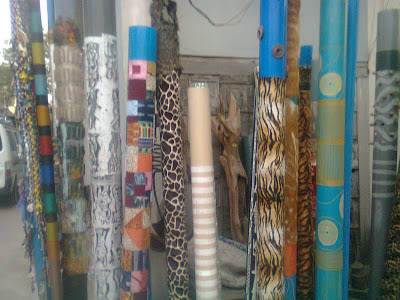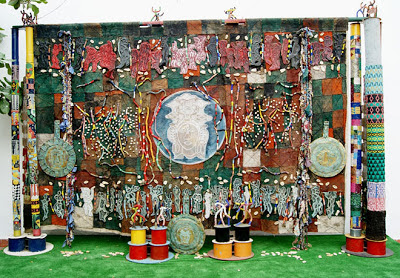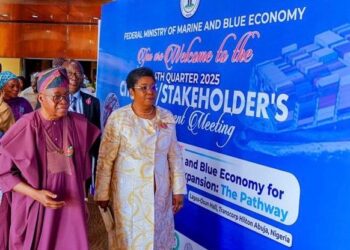For over half a century, Bruce Onobrakpeya , an octogenarian and a master of contemporary arts in Africa, has
remained bonded in love with his paint and brush and his crusade for the advancement of the Urhobo culture.
remained bonded in love with his paint and brush and his crusade for the advancement of the Urhobo culture.
In his gallery are works of art dating over 50 years, among many latest works. His collections which are well documented and archived reflect the wealth of experience of a veteran artist who has made iconic statements worthy of note.
Dance of the Golden Jubilee, by Onobrakpeya.2010.
Onobrakpeya’s contributions to art development remain remarkable through training programmes for young artists who come for industrial attachment. His art platform for telling some of Africa’s history earned him the ‘Living Art Treasure’ award from the Federal Government of Nigeria in corporation with UNESCO, and conferment of the honorary award of MFR.
In 2010, he received the ‘Creativity’ award as part of events marking Nigeria’s 50th Independence anniversary.
Onobrakpeya felt highly honoured because 1999 was the last time that award was given to recognise Chinua Achebe.
Onobrakpeya felt highly honoured because 1999 was the last time that award was given to recognise Chinua Achebe.
Recognised as the foremost printmaker, Onobrakpeya concentrated on printmaking art between 1964 and 1967. He has used his works of art as medium for projecting and preserving his native Urhobo culture, which was once rumoured to be among
minority group cultures in Africa likely to face extinction.
minority group cultures in Africa likely to face extinction.
Eghwere, mixed media installation, By Onobrakpeya
Nursing no fears about cultural extinction of the Urhobos particularly, Onobrakpeya believes that the philosophy of the Urhobos and those of other cultures he captures in his works would endure the ages to come, bearing in mind the publicity given the annual ‘Harmattan Workshop’ that pools resources from around the world.
To further strengthen the base for which he is making his mark in cultural affairs, Onobrakpeya delved into folklore which
records the way of life of his people. He said, “ I realized that if people have been in existence for long, there must be some thinking and belief in them, some hope in them that keeps them going. These are brought out and translated in various ways, in the names they give to their children and in their thought pattern.”
records the way of life of his people. He said, “ I realized that if people have been in existence for long, there must be some thinking and belief in them, some hope in them that keeps them going. These are brought out and translated in various ways, in the names they give to their children and in their thought pattern.”
Lately, he went into what is called the ‘ibiebe’ that is like letters , though ‘ebe’ means leaves in Urhobo. He developed some ideograms that captured the concept, the Urhobo thinking, as a way of conserving the culture of the Urhobo people ,and moved on to other ethnic groups. He said, “They are mainly oral, but I now give body to them through painting, drawing so that people can see them, and that keeps the concept alive and projected towards the future.”
Growing up, he was educated at different times in Ughelli, Sapele and Benin. Before going to the Nigerian College of Arts ,Science and Technology in Zaria, he worked briefly as a teacher. In school, he studied painting and got a special interest in printmaking which is an aspect of painting.
He recalled how the art workshops organized by a renowned artist helped to establish his guts in printmaking. “ During my last year in school, I would usually come all the way to Ibadan to attend workshops by Uli Bier who brought resource persons from abroad to handle these workshops. There, I realized that printmaking was my calling which I should have done in college. I missed that out due to peer pressure.”
Onobrakpeya continued teaching for another 17 years at St. Gregory’s College, Ikoyi, after his graduate and post-graduate programmes. But while teaching, he had the vision of developing himself through various workshops that gave him the opportunity to travel abroad for better exposure. While abroad ,he became an artist-in-residence and earned himself a
similar position at the University of Ibadan where he was also made an associate professor.
similar position at the University of Ibadan where he was also made an associate professor.
By 1980, Onobrakpeya decided to work for himself than continue in the employment of another. He started by doing some sort of freelancing painting, and he had several exhibitions. By 1998, he created the ‘Harmattan Workshop’ with the Bruce Onobrakpeya Foundation to support it. Since then, the Foundation has been taking students, art professionals and those who
just appreciate the arts to Agbarha-Otor, where art skills are taught.
just appreciate the arts to Agbarha-Otor, where art skills are taught.
But for some time now, Onobrakpeya shifted attention more to what is called Installation, which has the background of shrines. In this case however, nothing fetish is done, it is only bringing together of materials from their different areas to create some kind of beauty for artistic purposes.
For Onobrakpeya, he said he has used the Urhobo culture as a launching pad to showcase the everyday lifestyle of the people. He has also not limited himself to just one culture, as he has done works to reflect the cultures of the Yorubas, the Igbos and those of the North which he understood by reason of his being there for five years.
Fulfilled by the large followership he enjoys, Onobrakpeya is more concerned about what he is doing than the recognition, even though there just may have been some recognition. He said, “The encouragement has been that one or two persons have
shown recognition and given support at some time. Back home at Agbarha-Otor, the people have shown so much appreciation after they came to understand the whole idea about the Harmattan Workshop.”
shown recognition and given support at some time. Back home at Agbarha-Otor, the people have shown so much appreciation after they came to understand the whole idea about the Harmattan Workshop.”
Looking at the kind of works of arts that are done by young artists, he sees a strong reflection of the environment and life around them. He says, “They paint in simple terms what they see as they grow, but as they get older, they just may begin to get complicated in their expressions. For somebody like me, my works appear complex because of the period through which I grew up, the things I saw and the ones that I experienced.”
#zariaartschool,#bruceonobrakpeya, #harmattanworkshop,#artandculture, #urhobo


